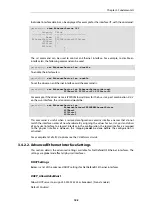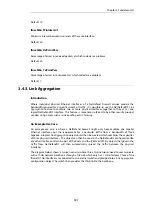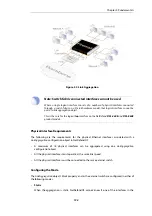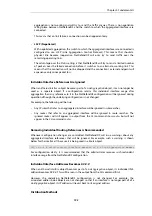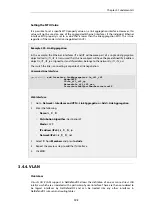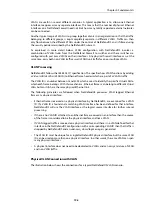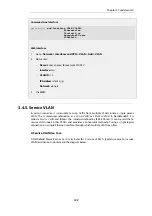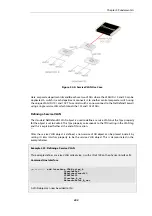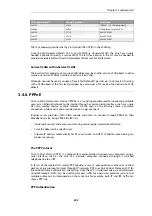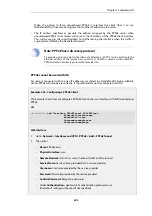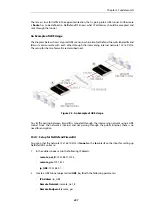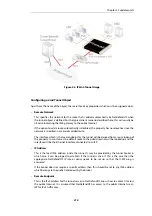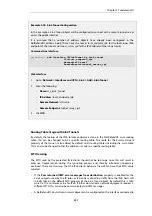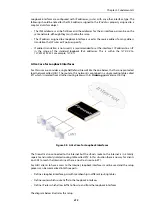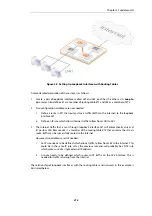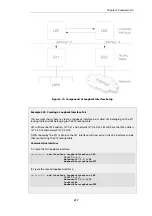
TPID (Hexadecimal)
Decimal Equivalent
Description
0x8100
33024
IEEE 802.1Q VLAN (the default)
0x88a8
34984
IEEE diffserv Service VLAN
0x9100
37120
0x9100 VLAN
0x9200
37376
0x9200 VLAN
0x9300
37632
0x9300 VLAN
The
Type
property specifies the
Tag Protocol Identifier
(TPID) in the VLAN tag.
Since the
VLAN
object defaults to a
Type
of
0x8100
(a standard VLAN), the only
Type
usually
needed is
0x88a8
to specify a service VLAN. The last three entries in the list may be needed to
provide interoperability with external equipment from some manufacturers.
Service VLANs within Service VLANs
The
BaseInterface
property of a service
VLAN
object can be another service
VLAN
object. In other
words, one service VLAN can contain another service VLAN.
Although unusual beyond a couple of levels, NetDefendOS permits up to 16 levels of nesting,
with a
VLAN
object at the first level wrapped by a maximum of 15 levels of nested service
VLAN
objects.
3.4.6. PPPoE
Point-to-Point Protocol over Ethernet
(PPPoE) is a tunneling protocol used for connecting multiple
users on an Ethernet network to the Internet through a common local interface, such as a single
DSL line, wireless device or cable modem. All the users on the Ethernet share a common
connection, while access control can be done on a per-user basis.
Internet server providers (ISPs) often require customers to connect through PPPoE to their
broadband service. Using PPPoE the ISP can:
•
Implement security and access-control using username/password authentication
•
Trace IP addresses to a specific user
•
Allocate IP address automatically for PC users (similar to DHCP). IP address provisioning can
be per user group
The PPP Protocol
Point-to-Point Protocol
(PPP), is a protocol for communication between two computers using a
serial interface, such as the case of a personal computer connected through a switched
telephone line to an ISP.
In terms of the layered OSI model, PPP provides a layer 2 encapsulation mechanism to allow
packets of any protocol to travel through IP networks. PPP uses Link Control Protocol (LCP) for
link establishment, configuration and testing. Once the LCP is initialized, one or several Network
Control Protocols (NCPs) can be used to transport traffic for a particular protocol suite, so that
multiple protocols can interoperate on the same link, for example, both IP and IPX traffic can
share a PPP link.
PPP Authentication
Chapter 3: Fundamentals
202
Summary of Contents for NetDefendOS
Page 30: ...Figure 1 3 Packet Flow Schematic Part III Chapter 1 NetDefendOS Overview 30 ...
Page 32: ...Chapter 1 NetDefendOS Overview 32 ...
Page 144: ...Chapter 2 Management and Maintenance 144 ...
Page 284: ...Chapter 3 Fundamentals 284 ...
Page 392: ...Chapter 4 Routing 392 ...
Page 419: ... Host 2001 DB8 1 MAC 00 90 12 13 14 15 5 Click OK Chapter 5 DHCP Services 419 ...
Page 420: ...Chapter 5 DHCP Services 420 ...
Page 573: ...Chapter 6 Security Mechanisms 573 ...
Page 607: ...Chapter 7 Address Translation 607 ...
Page 666: ...Chapter 8 User Authentication 666 ...
Page 775: ...Chapter 9 VPN 775 ...
Page 819: ...Chapter 10 Traffic Management 819 ...
Page 842: ...Chapter 11 High Availability 842 ...
Page 866: ...Default Enabled Chapter 13 Advanced Settings 866 ...
Page 879: ...Chapter 13 Advanced Settings 879 ...

